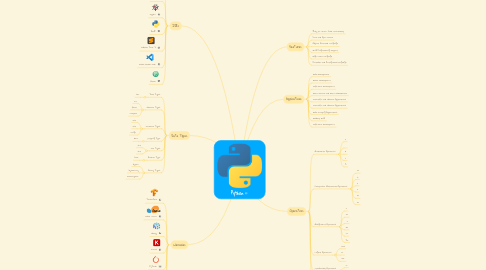Python
by Omar Ashraf Ramadan


1. IDEs
1.1. PyCharm
1.2. Kite
1.3. Spyder
1.4. IDLE
1.5. Sublime Text 3
1.6. Visual studio code
1.7. Atom
2. Data Types
2.1. Text Types
2.1.1. str
2.2. Numeric Types
2.2.1. int
2.2.2. float
2.2.3. complex
2.3. Sequence Types
2.3.1. list
2.3.2. list
2.3.3. range
2.4. Mapping Type
2.4.1. dict
2.5. Set Types
2.5.1. set
2.5.2. set
2.6. Boolean Type
2.6.1. bool
2.7. Binary Types
2.7.1. bytes
2.7.2. bytearray
2.7.3. memoryview
3. Libraries
3.1. TensorFlow
3.2. Scikit-Learn
3.3. Numpy
3.4. Keras
3.5. PyTorch
3.6. LightGBM
3.7. SciPy
4. Features
4.1. Easy to Learn, Code and Develop
4.2. Free and Open Source
4.3. Object-Oriented Language
4.4. GUI Programming Support
4.5. High-Level Language
4.6. Portable and Integrated language
5. Applications
5.1. Web Development
5.2. Game Development
5.3. Software Development
5.4. Data Science and Data Visualization
5.5. Scientific and Numeric Applications
5.6. Scientific and Numeric Applications
5.7. Web Scraping Applications
5.8. Desktop GUI
5.9. Software Development
6. Operators
6.1. Arithmetic Operators
6.1.1. +
6.1.2. -
6.1.3. *
6.1.4. /
6.1.5. %
6.2. Comparison (Relational) Operators
6.2.1. ==
6.2.2. !=
6.2.3. >
6.2.4. <
6.2.5. >=
6.2.6. <=
6.3. Assignment Operators
6.3.1. =
6.3.2. +=
6.3.3. -=
6.3.4. *=
6.3.5. /=
6.3.6. %=
6.4. Logical Operators
6.4.1. and
6.4.2. or
6.4.3. not
6.5. Membership Operators
6.5.1. in
6.5.2. not in
6.6. Identity Operators
6.6.1. is
6.6.2. not is
